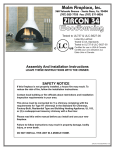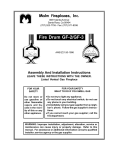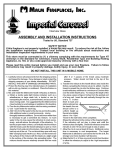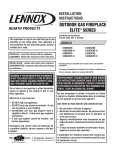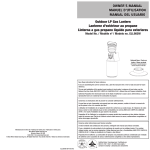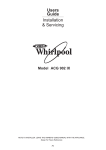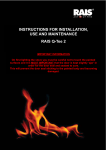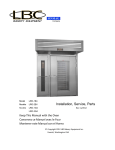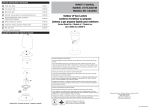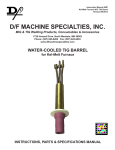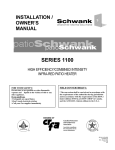Download Malm Fireplaces Fire Drum 2 Specifications
Transcript
Malm Fireplaces, Inc. 368 Yolanda Avenue, Santa Rosa, CA 95404 (707) 523-7747 - Fax: (707) 571-8036 [email protected] Fire Drum 2 Tested to U/L Standards 1482 and 737 Assembly And Installation Instructions Read Instructions carefully before starting. Installation must comply with all local and national codes. A building permit must be obtained before starting installation. All parts must be in place or listing will be void. Assembly Instructions Remove and set aside the smaller carton. It is not necessary to open this carton before moving it. It is now possible to open the larger carton. Carefully unpack all parts from cartons as directed below carefully inspecting all parts. If any parts are damaged or missing, contact shipper or dealer immediately. Do not install unit using damaged parts. Damper Section Connector Shield Top Metal Hood Top Refractory Fiberglass strip Screen Hinge Fiber Glass Strip Optional Baffle Baffle Spacer & Bolt Screen Side Wall Refractory Bricks Screen Hinge Groove in Bottom Refractory Bottom Fire - Bowl Assembly Illustration No. 1. Fire Drum 2 Continued 1. Open the top of the larger carton. Remove the corner packing supports. Lift out the top metal hood and then lift out the top refractory casting. Be careful not to drop this refractory piece. Remove the center packing pad. It is not necessary to remove the bottom refractory casting from the fire-bowl assembly, this should remain in place in the bottom fire-bowl assembly. 2. Lift out the bottom fire-bowl assembly or slit open one side of the carton for access to the assembly. NOTE: Due to the weight of the fully assembled fireplace unit it would be advisable to temporarily position the bottom fire-bowl assembly in the desired location for installation. The metal hood may be set on the base assembly without the top refractory casting or side wall refractory bricks in order to determine the chimney location. The floor protection (hearth extension) size and location should be determined at this time also. Refer to installation Instructions. The base assembly should now be removed and the chimney and hearth extension installed. The fireplace assembly can then be continued and completed after the chimney and hearth extension are installed. 3. Open the smaller carton now and remove the corner packing supports, the screen box, Metal Fireplace Wall Cap Screw 2 Spacer Bolt head to inside 3 Optional Baffle Side Wall Refractory Bricks 1 Thru 4 4 1 Bottom Screen Hinge Make Certain Fiberglass Strip Seal Begins At This Point And Ends At The Same Point On The Other Side Opening Fin Illustration No. 2 Page - 2 Fire Drum 2 Continued Illustration No. 3 baffles (if this unit included the optional convection baffles), the damper housing carton and the additional 9" X 24" connector flue pipe carton. 4. Refer to Illustrations No. 1 and No. 2 for identification of parts and relationships referred to in these Assembly Instructions. 5. Carefully lift out the curved side wall refractory bricks. Place these aside for later installation. Please note the top and bottom of these bricks for proper installation later. 6. Now lift out the metal cylindrical fireplace wall (body section). 7. Place the body section on the fire-bowl assembly so that it is seated in the depressions provided for in the refractory casting. Notice that other depressions are provided around the circumference of the back of the fireplace for the bottom edge of the body section. Make the body section seat into this groove. At this point the body section should be seated into all the depressions, grooves, and slots provided for it in the refractory casting. Page - 3 Fire Drum 2 Continued NOTE: For units ordered with optional convection baffles, installation of the baffle attachment hardware must be done at this point. Connect the four (4) spacers to the body in the holes provided. The hex head bolt should be to the inside. Tighten the hex head bolt to a firm, tight condition using a 9/16" wrench. If the unit is a porcelain finished unit do not over tighten the hex head bolts or damage to the porcelain finish may result. 8. Place the side wall refractory bricks back in the body section just as they came out of the shipping carton. The tongue on the bottom of the bricks will fit into the groove provided in the bottom fire bowl refractory casting. These bricks should all fit into place so that the tops of the bricks are at the same level. 9. Unpack the screen carton and remove the gasketing material provided into the groove located in the top of the side wall refractory bricks. Begin placing the gasketing material at the opening fins connection point. Refer to Illustration Number 2. Care should be taken to fill the groove around the circumference of the body section. 10. The top refractory casting may now be placed into position. Rotate the top refractory casting so that the positioning grooves match the opening fins of the metal fireplace wall and top of the body opening channel. This casting must fit down into the metal fireplace wall, and slight movement may be necessary to insure the refractory casting is down evenly on the tops of all the side wall refractory bricks. Also check to see that the top refractory casting has seated onto the top of the opening channel completing the seal around the full circumference of the body section. 11. The top metal hood will now drop on and seat into place. 12. Unpack the damper housing (Part Number DH 2) which also contains the connector shield (Part Number CS 2). 13. Place the connector shield in the upper refractory opening. Refer to the illustrated sheet packed with the damper housing and the connector shield for the proper installation. Refer to Illustration No. 3. 14. Seat the damper housing (the flue pipe section with the damper plate and handle) into the Page - 4 Fire Drum 2 Continued Illustration No. 4 metal hood collar making sure that the slots around the circumference of the pipe are immediately above the collar of the fireplace unit. The damper plate contained in the damper housing should now rotate at least 90 degrees. That is, from a horizontal position to a vertical position. (The damper plate handle is fixed in the same relative position as the damper plate.) Refer to Illustration No. 4 15. A screen is provided and should be left in place over the opening of the fireplace at all times when in use. The screen is lifted into place in the opening and held by the screen hinge rod attached to the frame of the screen. The screen hinge rod engages a hole on the left of the body channel at the top and the body hinge slug at the bottom. 16. Your fireplace unit is now ready for installation. 17. Continue on to the next section. Read Installation Instructions. Page - 5 Fire Drum 2 Continued Installation Instructions Do Not Install In A Mobile Home. READ ALL INSTRUCTIONS CAREFULLY BEFORE STARTING THE INSTALLATION. 1. Position unit to comply with the minimum clearances to combustible materials. Minimum clearances are shown from the chimney connector. It is recommended that no overhead cross members in the ceiling or roof be cut. Reposition unit if necessary, being careful not to move closer than the minimum clearances. The minimum clearances to combustibles are as follows: A. Side wall/Back wall Installation: 19 1/2" a. 19 1/2 inches from the back of the chimney connector to the back wall. b. 35 1/2 inches from the side of the chimney connector to the side wall. See Illustration No. 5. 35 1/2" Illustration No. 5 B. Corner Installation: 23 1/2" a. 23 1/2 inches minimum as measured from the side of the chimney connector to the nearest wall. See Illustration No. 6. 2. Install chimney and accessories through 23 1/2" Illustration No. 6 Page - 6 Fire Drum 2 Continued ceiling and roof directly above unit per chimney manufacturer's instructions. Chimney must be U.L. listed 8 inch Low Heat Residential Appliance Type Chimney (All Fuel). Before Chimney is installed use a plumb-bob to assure that chimney is directly above the flue outlet on unit. See Typical Installation Illustration No. 7. Note: We do NOT recommend use of the 8 inch chimney system with elbowed single-story installations of the Fire Drum 2, as more height is needed for adequate draft. Elbows aren't normally necessary in single story buildings in any case. Chimney System Chimney Connector Fireplace Unit Illustration No. 7 Page - 7 Fire Drum 2 Continued 3. A non-combustible hearth extension (floor protector) must be installed under the unit. This extension must be a minimum of 3/8 inch thick noncombustable material such as brick, concrete, slate, ceramic tile, or a listed floor protection board such as Wonderboard or Homosote. Check with local building authorities as to what other materials are acceptable. The hearth extension must extend a minimum of 5 1/2 inches beyond the back and sides of the unit and 16 inches beyond the front opening of the unit. Mark location of required hearth extension on the floor. Refer to Illustration No. 8. 5 1/2" 5 1/2" 5 1/2" 4. Remove unit and install hearth extension. 16" 5. Position unit on hearth extension at the proper clearances with the flue outlet directly below chimney. Illustration No. 8 Rotate unit as needed to make certain front opening is positioned parallel to the back wall for a side wall/ back wall installation, or at a 45 degree angle to both walls for a corner installation. 6. Chimney connector installation depends on the brand of chimney system installed. If using Simpson Dura-Vent a Universal Connector part No. 1870 must be used. With Metalbestos either the DSA or DSAC single wall chimney connector part must be used. Security users require the UP adapter. With most chimney systems manufactured a similar part is available from the chimney system manufacturer. If necessary contact the chimney manufacturer for proper connection parts for your chimney system. Refer to Illustration No. 8. Page - 8 Fire Drum 2 Continued Insulated Pipe Insulated Class "A" Chimney System Ceiling Single Wall Chimney Adapter 9" to 8" Slip Connector. Sheet Metal Screw to Chimney Connector. Sheet Metal Screw 8" to 9" Slip Connector Middle Pipe Section Bottom Fits Into Damper Section Dura-Vent Universal Adapter, Security UP Adapter, Metalbestos DSAC or DSA ,Or Single Wall Chimney Adapter Damper Pipe Bottom Fits Into Unit Unit Illustration No. 8 7. First install the 8" to 9" x 18" long pipe over the chimney system's single wall adapter. Sheet metal screw the connector to the single wall adapter using sheet metal screw in the holes provided. Slide the middle section of pipe over the 18" long pipe allowing enough room to insert the damper section between the fireplace unit and the bottom of the middle pipe. Install the damper section into the fireplace. Slide the middle pipe section into the damper section. 8. Check that all the clearances are still within the allowable specifications. 9. Read Operating and Maintenance Instructions. Page - 9 Fire Drum 2 Continued 2" Clearance From Studs To Chimney Wall Header 12" Of Brick From Liner To Combustables 5/8" Fireclay Liner Minimum or Equivalent 12" Minimum Sill/Support 12" Minimum MASONRY THIMBLE Masonry Chimney If using a masonry chimney, it must meet the minimum standards of the National Fire Protection Association (NFPA) Standard 211. The chimney must have at least a 5/8" fire clay liner or a listed chimney liner system. The chimney must be inspected for cracks, loose mortar, or any other signs of deterioration. It is best to have the chimney inspected by a professional. Make certain the chimney is cleaned prior to installation of this fireplace. The size of the chimney should be between 36 and 96 square inches. Larger chimneys should be relined to meet these requirements. Incorrect sizing of the chimney may affect the draft and result in poor fireplace performance. Do not install more than one appliance to any chimney. There are different accepted methods of connecting the fireplace to a masonry chimney through a combustible wall. This type of installation requires the use of a thimble to protect the surrounding combustible materials. Check with your local building officials or consult NFPA211. Page - 10 Fire Drum 2 Continued OPERATING INSTRUCTIONS Failure to properly use and maintain this appliance may void the manufacturer's warranty and could result in a house fire. WARNING: This free standing fireplace is a heat producing appliance and may cause severe burns if touched. Keep children away. Do Not over fire. If any portion of the unit or flue starts to glow you are over firing. This is a free standing fireplace, do not use for any other purpose. 1. The first few fires should be small in order to properly cure the painted surfaces and refractory. During the first few fires, some smoking may occur as the paint cures. You may wish to open a window to minimize discomfort during this curing period. 2. DO NOT BURN TRASH OR GARBAGE IN THIS UNIT. When building a fire, be sure the damper is fully opened and sufficient combustion air is available. Place dry kindling on dry wadded paper then ignite with a match. Add progressively larger pieces of wood until the fire is well established. Leave the damper fully open. Close only after the fire has burned out completely. Add additional firewood as needed to maintain the fire. 3. The fire screen must be in place during operations. WARNING: FIREPLACE STOVES EQUIPPED WITH DOORS SHOULD BE OPERATED ONLY WITH DOORS FULLY OPEN OR DOORS FULLY CLOSED. IF DOORS ARE LEFT PARTLY OPEN, GAS AND FLAME MAY BE DRAWN OUT OF THE FIREPLACE STOVE OPENING, CREATING RISKS FROM BOTH FIRE AND SMOKE. 4. Keep the pipe damper in the full open position when the fireplace is being used. 5. CAUTION: Heating the air in a closed building decreases the relative humidity of the air, which will dry wood and other combustible materials. This drying lowers the ignition temperature of these materials thus increasing fire hazards. To reduce the risk of fire, some provision should be made for replenishing moisture to the air whenever a structure is being heated for extended periods. 6. Be sure to provide combustion air into the dwelling when using this or any other wood burning appliance. A partially open window or outside air register in the vicinity of the unit would be acceptable. Combustion air must be supplied in conformance with the Uniform Mechanical Code. 7. CAUTION: NEVER USE GASOLINE, GASOLINE TYPE LANTERN FUEL, KEROSENE, CHARCOAL LIGHTER FLUID, OR SIMILAR LIQUIDS TO START OR “FRESHEN UP” A FIRE IN THIS HEATER. KEEP ALL SUCH LIQUIDS WELL AWAY FROM THE HEATER WHILE IN USE. 8. DISPOSAL OF ASHES: Ashes should be placed in a metal container with a tight fitting lid. The closed container of ashes should be placed on a noncombustible floor or on the ground, away from all combustible materials, pending final disposal. The ashes should be retained in the closed container until all cinders have thoroughly cooled. 9. READ MAINTENANCE INSTRUCTIONS. IN CASE OF A CHIMNEY FIRE A safe and correct installation and extra care will help prevent a fire, but accept the idea that there could be a fire. Be prepared to handle it. Make certain everyone in the house is familiar with the warning signs of a chimney fire: 1. Call the Fire Department immediately, before doing anything else. 2. Discharge a dry chemical extinguisher into the fireplace opening. If an extinguisher is not available, toss baking soda into the opening. Do not pour water on the fire. 3. Close all air intakes to the firebox and leave closed until the fireplace, stove or stove pipe is completely cooled. 4. Watch for sparks on the roof. If necessary, hose down the roof around the chimney. DO NOT pour water down or on the chimney. 5. After the fire is completely out, inspect the chimney for any signs of damage. If you are not certain, have your local Fire Department inspect the chimney for you. 6. Never use coal in a fireplace. Coal should be used only in stoves especially designed to burn coal. If the toxic gases produced enter the room they can be fatal. Page - 11 Fire Drum 2 Continued MAINTENANCE INSTRUCTIONS Failure to properly use and maintain this appliance may void the manufacturer's warranty and could result in a house fire. 1. Always keep the area around the unit clean and clear of furniture and other objects. Keep all furniture a minimum of 48 inches away from the heater. 2. Periodically the entire unit, chimney connector, and chimney system must be inspected for leaks, broken or malfunctioning parts, and loose connections. If any problems are noted, contact your dealer for repair services. Do not operate the unit until repairs have been completed. CREOSOTE FORMATION AND THE NEED FOR REMOVAL. When wood is burned slowly, it produces tar and other vapors, which combine with moisture to form creosote. Creosote vapors condense in the relatively cool chimney flue, and creosote residue accumulates on the flue lining. When ignited, this creosote can make an extremely hot fire. The chimney connector and chimney should be inspected at least twice monthly during the heating season to determine if creosote buildup has occurred. If creosote has accumulated, it should be removed to reduce the chance of a chimney fire. HOW TO REMOVE CREOSOTE. 1. Clean the chimney with brushes and equipment available at local fireplace shops. 2. Chemical chimney cleaners are used by adding them to the fire, but they are not intended for use in chimneys already containing heavy soot deposits. Rather, they are intended to inhibit soot buildup. They can be used in metal chimneys provided the manufacturers instructions are strictly followed. Generally these commercial cleaners are quite effective. 3. Call a professional chimney sweep in your area. They possess the experience and tools necessary to make the task easy. Maintenance other than the items specifically mentioned herein are to be performed by a qualified serviceman only. Contact your dealer. For further information on using your heater safely, obtain a copy of the National Fire Protection Association publication "Using Coal and Wood Stoves Safely," NFPA HS-10-1978. The address of the NFPA is Batterymarch Park, Quincy, MA 02269. File these instructions for future reference. NEVER STORE OR ALLOW PAPERS, KINDLING, FIREWOOD OR ANY OTHER COMBUSTIBLES WITHIN 48 INCHES OF UNIT. Malm Fireplaces, Inc. 368 Yolanda Avenue Santa Rosa, Ca. 95404 707 523-7755 Fax: 707 571-8036 [email protected] www.malmfireplaces.com












